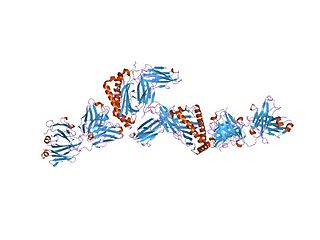
The X chromosome is one of the two sex-determining chromosomes (allosomes) in many organisms, including mammals, and is found in both males and females. It is a part of the XY sex-determination system and XO sex-determination system. The X chromosome was named for its unique properties by early researchers, which resulted in the naming of its counterpart Y chromosome, for the next letter in the alphabet, following its subsequent discovery.

Melanoma-associated antigen 1 is a protein that in humans is encoded by the MAGEA1 gene.

Carcinoembryonic antigen-related cell adhesion molecule 1 (CEACAM1) also known as CD66a, is a human glycoprotein, and a member of the carcinoembryonic antigen (CEA) gene family.

Melanoma-associated antigen 3 (MAGE-A3) is a protein that in humans is encoded by the MAGEA3 gene.

Melanoma-associated antigen 4 is a protein that in humans is encoded by the MAGEA4 gene.

Melanoma-associated antigen C2 is a protein that in humans is encoded by the MAGEC2 gene.

Melanoma-associated antigen D2 is a protein that in humans is encoded by the MAGED2 gene.

G antigen family D member 2 is a protein that in humans is encoded by the XAGE1D gene.

Sperm protein associated with the nucleus on the X chromosome A is a protein that in humans is encoded by the SPANXA1 gene.

Protein SSX5 is a protein that in humans is encoded by the SSX5 gene.

Melanoma-associated antigen 9 is a protein that in humans is encoded by the MAGEA9 gene.

HORMA domain-containing protein 1 (HORMAD1) also known as cancer/testis antigen 46 (CT46) is a protein that in humans is encoded by the HORMAD1 gene.

Radial spoke head 1 homolog (RSPH1), also known as cancer/testis antigen 79 (CT79) or testis-specific gene A2 protein (TSGA2), is a protein that in humans is encoded by the RSPH1 gene.

Melanoma antigen family A, 8 is a protein that in humans is encoded by the MAGEA8 gene.
Cancer/testis (CT) antigens are a group of proteins united by their importance in development and in cancer immunotherapy. In general, expression of these proteins is restricted to male germ cells in the adult animal. However, in cancer these developmental antigens are often re-expressed and can serve as a locus of immune activation. Thus, they are often classified as tumor antigens. The expression of CT antigens in various malignancies is heterogeneous and often correlates with tumor progression. CT antigens have been described in melanoma, liver cancer, lung cancer, bladder cancer, and pediatric tumors such as neuroblastoma. Gametogenesis offers an important role for many of these antigens in the differentiation, migration, and cell division of primordial germ cells, spermatagonia spermatocytes and spermatids. Because of their tumor-restricted expression and strong in vivo immunogenicity, CT antigens are identified as ideal targets for tumor specific immunotherapeutic approaches and prompted the development of several clinical trials of CT antigens-based vaccine therapy. CT antigens have been found to have at least 70 families so far, including about 140 members, most of which are expressed during spermatogenesis. Their expression are mainly regulated by epigenetic events, specifically, DNA methylation.

Cancer/testis antigen 83 is a protein that in humans is encoded by the CT83 gene.

MAGEA10 is a protein-coding gene in humans clustered at chromosomal location Xq28.

SPANX family member N1 is a protein that in humans is encoded by the SPANXN1 gene.

Cancer/testis antigen 55 is a protein that in humans is encoded by the CT55 gene.

LY6/PLAUR Domain Containing 6B, also known under the name Cancer/Testis Antigen 116 (CTA116) and LYPD7 is encoded by the LYPD6B gene. LYPD6B is a member of the lymphocyte antigen 6 (LY6) protein family. It is expressed in the testis, lungs, stomach, prostate and in the nervous system where it acts as a modulator of nicotinic acetylcholine receptor (nAChRs) activity.









